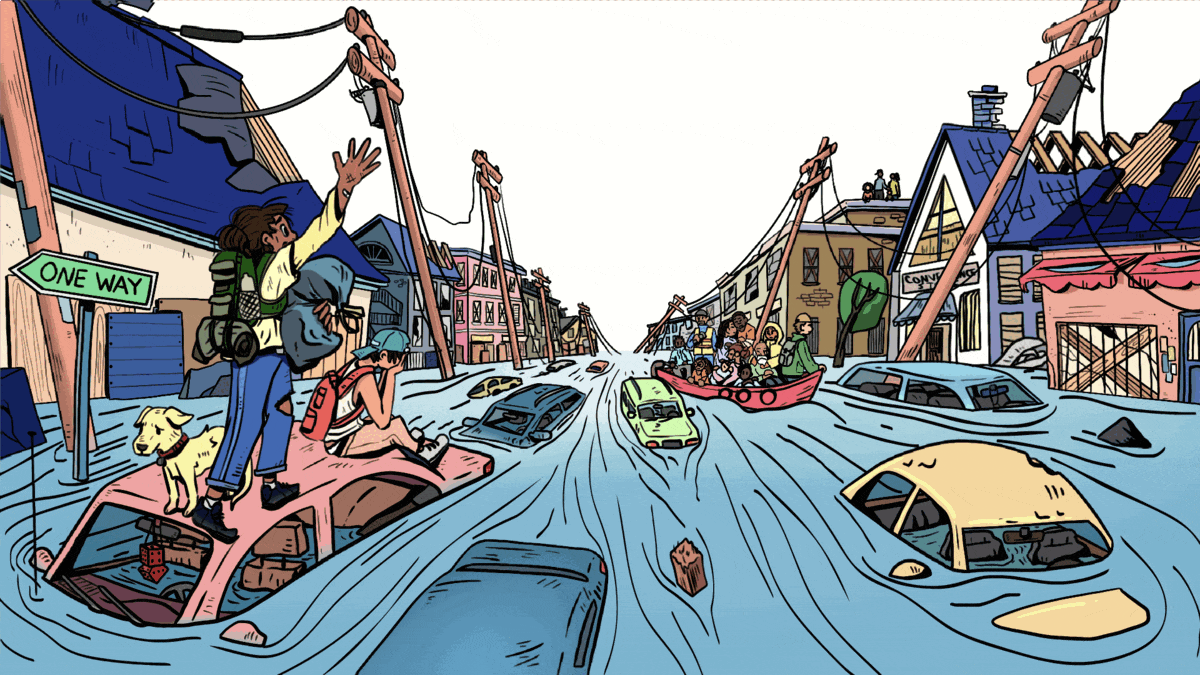Resources for bringing climate justice into the classroom
See resources below

In early 2025, we spoke to primary and secondary educators in England and Ireland about bringing a climate justice focus into their classroom teaching. We invited them to share any resources that they had found helpful in creating this focus.
One of the main messages we got from interviewing educators was that finding good resources for teaching on climate justice can be hard, and the idea of trawling through lots of websites is off-putting. So, on this website we have tried to keep things simple. We have profiled 20 resources only, and will periodically rotate these as we find new resources.
All of the resources on this page have been selected for one or more of the following reasons:
they foreground climate justice;
they are ‘off the shelf’ resources - teachers don’t need to register or do substantial extra work to adapt them for the classroom;
they foreground the voices of children and young people from a range of global contexts;
in some cases, educators we interviewed gave very specific examples of how they had used them to teach on climate justice;
in other cases, they are resources created by trusted organisations, or resources sourced by the research team because they align with what educators told us was important in teaching on climate justice.
The resources include poems, images, documentaries, games and roleplays, outdoor activities, and lesson plans incorporating a range of creative ideas. Where possible, we have included brief testimonies of how educators have used these or similar resources in their classrooms, or how they plan to do so.
We are open to suggestions for further resources. We would also love to hear more testimonies of using the resources listed here! For this, you can use the comments box on each resource page.
Resources are tagged to the following ages that align to key educational stages: 3-7 (pre-primary and lower primary); 5-11 (primary), 7-11 (upper primary), 11-14 (lower secondary); 14+ (upper secondary). Most of the resources could be used with multiple age groups, but they are tagged to the age group that the resource was principally designed for, or that the educator who recommended the resource had used it with. Where pages feature multiple resources for different age groups, they are tagged with the age group for each resource, and we have further signposted this on the resource page.
Some resources may have been developed for specific subjects or curricula, however we have not tagged resources to a subject area, as we believe climate justice education can and should be embedded across all subjects. Likewise, we know educators are very adaptable, and can adapt resources designed for a specific curriculum to their own needs.
Resources are organised using one or more of the following tags (the size of the text for each reflects the number of resources tagged):

“Climate change is a challenge that few want to take on, but the price of inaction is so high”. This statement marks part of the speech by Ms. Kathy Jetnil-Kijiner, Civil Society Representative from the Marshall Islands, who was selected from over 500 applicants to address the opening of the United Nations Climate Summit in 2014.
This activity helps to highlight climate justice issues using carbon emission and vulnerability data for a selection of countries using ‘Top Trump’ cards. Students compare countries’ historical carbon emissions and their vulnerability to climate change, revealing that nations with lower emissions often face greater climate impacts. This activity emphasises the need for equitable climate policies and international support for vulnerable countries, underscoring the importance of addressing climate justice by helping those who have contributed least to the problem but suffer the most.
The creators of these resources write:
“Educating children on the impact of their food choices is essential in nurturing future generations that are both health and environmentally conscious. With this in mind, ProVeg UK have developed a brand-new educational programme – Canteen to Classroom – in order to teach children about the food they eat: where it comes from, how it is made, and its impact on our health and the planet. With 24 high-quality, evidence-based free lesson plans, we save teachers precious time and effort.”
Climate Stories Project is “an educational and artistic forum for sharing personal stories about the changing climate” where individuals share their own story of how they are aware of climate change in their location. The idea is to use these stories to build a crowd-sourced inclusive and effective movement to confront the climate crisis.
This resource – created in collaboration with Climate Museum UK – focuses on the locations of Jamaica and Nigeria to explore questions about British colonialism and links to the climate crisis we face today.
The overarching question: ‘What are the links between colonialism and the environment?’ focuses on the exploration of companies and nations that have mechanisms to allow them to operate in other countries – military power, legal challenges, land-grabs and ‘social licence’.
Trócaire, an overseas development agency of the Catholic Church in Ireland, has worked with educators to produce resource packs for primary, senior primary, and post-primary classes respectively.
The resources were designed with Irish contexts and curricula in mind, however educators outside of Ireland will have no problems adapting the resources to context where necessary. Similarly, many of the activities and thematic content can be used and adapted by educators working at different educational stages.
Reboot Education’s fully supported climate-crisis curriculum aims to empower the climate strike generation.
Lessons from ThoughtBox introduce the cause & effect of climate change, exploring some of the science and relating it to local contexts. Students will understand the impact of climate change on human and non-human communities and engage with the values and emotions that we are all experiencing, helping to inspire positive actions and empowerment moving forward.
Global Inequalities and the Climate Crisis (GICC) is a curriculum resource that supports geography teachers to explore the relationships between global inequality and the climate crisis with Key Stage 3 classes, using the country of Cameroon as a case study.
The resource was produced in partnership with the Decolonising Education for Peace in Africa (DEPA) project, funded by the Economic and Social Research Council’s Global Challenges Research Fund as well as Impact Accelerator Account funding from the University of Lancaster.
We’ve got everything you need to bring the climate conversation to your classroom.
We’ve split up our KS3 climate resources into six handy topic areas and they cover a range of subjects: Art, Drama, English, Geography, History, PSHE, Religious studies, Science and Technology.
Concern Worldwide regularly hold international forums for student-led debates relating to development issues and the work of Concern. This web page includes resources to support schools that wish to take part in the international forum, but also includes resources that could be adapted to stage a debate in the classroom, with educators and students taking on different roles of chair, timekeeper, etc.
As feelings of eco-grief and climate anxiety grow, educators are grappling with how to help students learn about the violent systems causing climate change while simultaneously navigating the emotions this knowledge elicits. This book provides resources for developing emotional and existential tenacity in college classrooms so that students can stay engaged.
This book, aligned to the Irish Junior Cycle Religious Education curriculum, explores five major world religions and humanism and includes ideals of diversity and inclusivity.
The themes of social and environmental justice run across the text, and activities are designed to prompt respectful debate and inclusive insight. Chapters and courses focus upon stewardship and the environment through creative writing.
This booklet was produced as part of Young People at a Crossroads, a research project in which researchers worked with migrant-background young people in Manchester, UK and Melbourne, Australia to explore migrant family perspectives on climate change education, action and adaptation. These perspectives were published in a creative book that was co-authored by young participants in the project.
These sets of resources, aimed at ages 9-11 (primary pack) and 11-16 (secondary pack) respectively each offer ways of bringing climate justice into the context through five interlinked topics.
The topics can be used sequentially or as standalone topics. Each topic comes with a lesson plan, incorporating stories, pictures, film and role play to investigate the human element of the climate crisis in age and curriculum-appropriate ways.
Christian Aid has produced a set of interactive activities for small groups to critically explore the impacts of weather-related disasters in different contexts.
The worksheets and assembly resources use real world examples and images to explore how the impacts of disasters differ and how this relates to pre-existing inequalities. This can be a segway into introducing climate justice.
A resource to break a problem down into its cause: The Root Cause Tree assists students in identifying the main cause of a problem and giving them a comprehensive understanding of the related causes and consequences. The tree provides a visual structure for analysis of the problem.
World champion poet and UNHCR Goodwill Ambassador, Emtithal (Emi) Mahmoud’s wrote the poem, Di Baladna, which means Our Land in Arabic, following a series of discussions with refugees living on the front lines of the climate crisis in Bangladesh, Cameroon, and Jordan.
Howard Magazine (from Howard University, USA) have produced a series of images exploring aspects of natural hazards, climate change and justice and woven them into a short critical essay on climate justice.
WaterAid provides clean water, sanitation and hygiene education to some of the world’s poorest people. Their Pupil Pipeline project is a fun and educational water delivery challenge for schools that will help bring clean water to communities around the world, like Finote Selam’s primary school.




















This education pack for secondary schools can provide a segway into conversations about climate justice by opening up how the climate crisis affects farmers and workers in overseas countries. Through the materials in this pack, young people will have the opportunity to discover how their choices can have an impact on people around the world, but also on the planet that we live on.